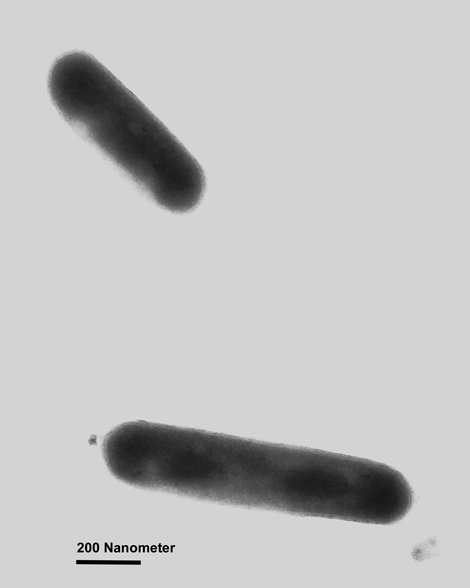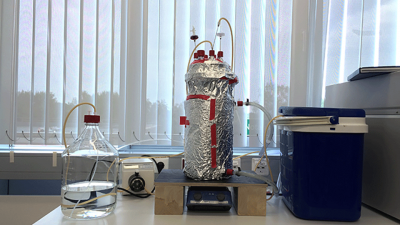Page path:
- Home
- Discover
- Media Releases
- Media Releases 2016
- Molecular paleothermometer put to the test
Molecular paleothermometer put to the test
Reconstruction of the ocean’s surface-water temperatures is an important component of paleoclimate research. A team that includes Sarah Hurley of Harvard University (Cambridge, MA, USA) and Felix Elling of MARUM - Center for Marine Environmental Sciences at the University of Bremen is now investigating previously overlooked biological aspects of the TEX86 paleothermometer. Scientists use this organic geochemical method to estimate ocean temperatures in the past. Molecular fossils preserved in the sea floor reveal information about environmental conditions in the past. The new study shows that not only temperature but also the respiration rate of the microplankton influences the composition of these molecular fossils. The team has now published its results in the Proceedings of the National Academy of Sciences (PNAS).
Archaea are one-celled microorganisms and represent one of the most abundant life forms in the nutrient-poor oceans. An important group of marine archaea, the ammonia-oxidizing archaea, oxidize ammonia and, like plants, form their cell components from carbon dioxide. A peculiarity that distinguishes archaea from bacteria and higher life forms is the chemical composition of their membrane. It is composed of a layer of lipids (fats) that forms a boundary layer between the internal cell and the surrounding environment. After growing at the surface, the archaea slowly sink to the sea floor and accumulate there over time. The membrane lipids of planktonic archaea are extremely stable and their remains can be recovered in marine sediments after millennia. They are organic fossils that provide information about their growth conditions in the past. One important proxy that is based on the composition of archaean lipids is the temperature indicator TEX86, which geochemists use to reconstruct past climate.
“Until now it has been assumed that archaea simply adapt the composition of their membrane to the water temperature. The link between membrane construction and water temperature, however, is not as simple as previously thought because the archaea adapt to a number of environmental stress factors. Our study indicates that the theory behind the temperature indicator TEX86 needs to be reconsidered,” says Dr. Felix Elling, who obtained his PhD at MARUM and has recently moved to Harvard University. The study by Sarah Hurley, Felix Elling and their colleagues was initiated when it was recognized that measurements of archaea at the water surface did not agree with values calculated from measurements in the sediment.
It has only been possible for about the past ten years to cultivate ammonia-oxidizing archaea in the laboratory and to study how various factors affect the growth of these organisms. PD Dr. Martin Könneke stresses that the cultivation was an important prerequisite for obtaining enough biomass to carry out reproducible experiments. Könneke leads the “Archaeal life in the ocean” group at MARUM.
This study, by scientists from Bremen and Harvard, shows that the lipids surrounding the microorganisms change not with temperature as previously believed, but with nutrient supply. It is the lipids that provide information about the nutrient availability through their structure and composition. Furthermore, says Könneke, there has been agreement with older data from closed cultivation systems and the ocean. “Our study shows that the ammonia oxidation rates, i.e. the respiration rates, influence the composition of the membranes of these archaeans independently from temperature.”
The working group at MARUM has dedicated about a year to their study of the effectiveness of the TEX86 temperature proxy in order to develop an open, continuous cultivation system in which to breed archaea. “It is notable that the system for cultivation is not a closed container, rather that the microorganisms are continually supplied with nutrients in low concentrations, just like in their natural environment,” explains Martin Könneke. The researchers have influenced the growth rates by introducing the nutrient solution to the containers sometimes faster and sometimes slower. But they stress that the temperature has always remained constant.
Archaea are one-celled microorganisms and represent one of the most abundant life forms in the nutrient-poor oceans. An important group of marine archaea, the ammonia-oxidizing archaea, oxidize ammonia and, like plants, form their cell components from carbon dioxide. A peculiarity that distinguishes archaea from bacteria and higher life forms is the chemical composition of their membrane. It is composed of a layer of lipids (fats) that forms a boundary layer between the internal cell and the surrounding environment. After growing at the surface, the archaea slowly sink to the sea floor and accumulate there over time. The membrane lipids of planktonic archaea are extremely stable and their remains can be recovered in marine sediments after millennia. They are organic fossils that provide information about their growth conditions in the past. One important proxy that is based on the composition of archaean lipids is the temperature indicator TEX86, which geochemists use to reconstruct past climate.
“Until now it has been assumed that archaea simply adapt the composition of their membrane to the water temperature. The link between membrane construction and water temperature, however, is not as simple as previously thought because the archaea adapt to a number of environmental stress factors. Our study indicates that the theory behind the temperature indicator TEX86 needs to be reconsidered,” says Dr. Felix Elling, who obtained his PhD at MARUM and has recently moved to Harvard University. The study by Sarah Hurley, Felix Elling and their colleagues was initiated when it was recognized that measurements of archaea at the water surface did not agree with values calculated from measurements in the sediment.
It has only been possible for about the past ten years to cultivate ammonia-oxidizing archaea in the laboratory and to study how various factors affect the growth of these organisms. PD Dr. Martin Könneke stresses that the cultivation was an important prerequisite for obtaining enough biomass to carry out reproducible experiments. Könneke leads the “Archaeal life in the ocean” group at MARUM.
This study, by scientists from Bremen and Harvard, shows that the lipids surrounding the microorganisms change not with temperature as previously believed, but with nutrient supply. It is the lipids that provide information about the nutrient availability through their structure and composition. Furthermore, says Könneke, there has been agreement with older data from closed cultivation systems and the ocean. “Our study shows that the ammonia oxidation rates, i.e. the respiration rates, influence the composition of the membranes of these archaeans independently from temperature.”
The working group at MARUM has dedicated about a year to their study of the effectiveness of the TEX86 temperature proxy in order to develop an open, continuous cultivation system in which to breed archaea. “It is notable that the system for cultivation is not a closed container, rather that the microorganisms are continually supplied with nutrients in low concentrations, just like in their natural environment,” explains Martin Könneke. The researchers have influenced the growth rates by introducing the nutrient solution to the containers sometimes faster and sometimes slower. But they stress that the temperature has always remained constant.
What significance does the study have for subsequent investigations? The MARUM geochemist Prof. Dr. Kai-Uwe Hinrichs considers the work to be an important step in providing a new point of view for ocean climate reconstructions studies. “We are not completely questioning the validity of the temperature signal, but it might be possible in the future to combine the temperature and growth rate,” says Hinrichs. The temperature proxy is applicable to sediments and the lipids contained therein. One has to keep in mind, however, that the presently measured values from archaeans in the water column cannot be explained. This indicates that the TEX86 temperature indicator cannot function as previously believed. “In our present study we suggest a mechanism that describes the formation of the archaean membrane from a biological point of view, as dependent on the respiration activity of the ammonia oxidizers,” says Felix Elling. “We hope thus to contribute to an improvement or even a new interpretation of the TEX86 proxy and temperature reconstructions.”
Original Publication:
Hurley S. J., Elling F. J., Könneke M., Buchwald C., Wankel S. D., Santoro A. E., Lipp J. S., Hinrichs K.-U. and Pearson A. (2016): Influence of ammonia oxidation rate on thaumarchaeal lipid composition and the TEX86 proxy. Published in: Proceedings of the National Academy of Sciences, USA
DOI: 10.1073/pnas.1518534113
Contakt:
PD Dr. Martin Könneke
Telefon: 0421 218 65747
E-Mail: [Bitte aktivieren Sie Javascript]
More Information:
Ulrike Prange
MARUM-Öffentlichkeitsarbeit
Telefon: 0421 218 65540
E-Mail: [Bitte aktivieren Sie Javascript]
Original Publication:
Hurley S. J., Elling F. J., Könneke M., Buchwald C., Wankel S. D., Santoro A. E., Lipp J. S., Hinrichs K.-U. and Pearson A. (2016): Influence of ammonia oxidation rate on thaumarchaeal lipid composition and the TEX86 proxy. Published in: Proceedings of the National Academy of Sciences, USA
DOI: 10.1073/pnas.1518534113
Contakt:
PD Dr. Martin Könneke
Telefon: 0421 218 65747
E-Mail: [Bitte aktivieren Sie Javascript]
More Information:
Ulrike Prange
MARUM-Öffentlichkeitsarbeit
Telefon: 0421 218 65540
E-Mail: [Bitte aktivieren Sie Javascript]

Ammonia-oxidizing archaea under the electron microscope.
Foto: MARUM, Universität Bremen, M. Könneke



